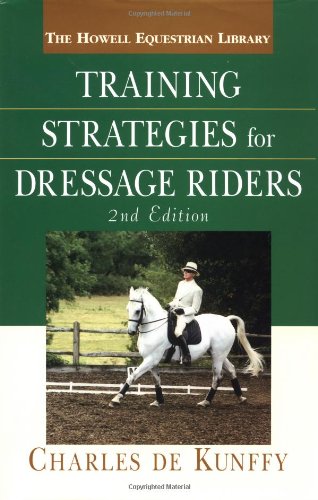Where to buy: Amazon, or there are a couple used copies on eBay
When we were in Maine this summer, we spent one rainy morning driving out to Bangor to try to find a battery charger for my camera. That was a complete fail by the way, but we passed a tack store in our journeys and obviously swung in so it wasn't a complete loss of a trip. Along with my sparkly spur straps, I also perused the consignment section and grabbed a couple of older books for $8 a piece.
One of them was Training Strategies for Dressage Riders by Charles de Kunffy, and I'm so glad I snagged this. It's one of the few training types books I sat down and read from cover to cover instead of flipping through and only reading the sections I thought were relevant to me.
As an aside, I've been living a lie my whole life and totally thought his last name was de Knuffy. Surely I can't be the only one who thought this? Or are my reading comprehension skills really just that poor? Probably the latter.
First of all, the most important takeaway I got from this book is this:
 |
| everyone should wear gloves, you savages. |
This book moves along in a fairly chronological order, from an overview on the goals of classical equitation and how to emulate the best riders and their positions to exercises on bending, flexion, and gymnastics for your horse. It wraps up with a look on judging, competition (and how to throw down a proper salute), and the best tack for dressage.
This book was originally published in 1984, and the one I linked to on Amazon is from 2003. I wonder if any of the pictures got updated because one of my favorite parts of this book is seeing young Arthur Kottas and Steffen Peters in pictures.
A few other takeaways I found interesting:
- The walk. He says many riders neglect the walk for various reasons. Some find it boring, while others feel it's too basic of a gait and is reserved for beginner riders. "Most of us do not 'fall in love' with the art of riding by being attracted to it by the walk. ... Had we desired to creep along at a slow pace, we could have saddled an ox." He also says that insufficient movement during a young horse's growing stages (not enough turnout) can lead to a poor walk.
- Changes. "The horse is ready for the flying change if he can maintain elasticity in performing the extended trot, half-passes with cadence at the trot, and collected canter." (Or if you're a racehorse and changes come easier than walking in a straight line, Bobby.) Elasticity is the key, these are just the movements that best show off if your horse has it.
- "The Thoroughbred is an excellent horse." Promising, right? Only it's the first sentence for the chapter titled Insubordination of Horse to Rider. That made me LOL. He goes on to say that while Thoroughbreds are the embodiment of athleticism, it's that very thing that makes them more difficult as a dressage prospect. They're so sensitive and can carry a past with a lot of baggage which makes the relaxation part of dressage not come easily to them.
- Bits. "The most gentle and therefore the most appropriate bit is a simple jointed snaffle. ... A bit with only one joint in the center is recommended." SUCK. IT. I can't stand reading people harp about how a single jointed snaffle is abuse and so harsh and yada yada. French links aren't for everyone. Bobby hates having any sort of middle piece to his bits and has always gone best in a simple single joint.
I've also gone back and re-read his section on the double now that we're starting to play with one a little bit. "The use of the full bridle must be earned by the horse and deserved by his rider." I've been reading everything I can find about the double lately because I'm kind of afraid of it still, but I thought it was funny that in this older book he preaches the use of 3-1 reins which is now considered completely out-dated.
 |
| looks way too confusing to me |
Overall this is one of those books that sits on my side table instead of in my bookcase. Its extensive list of exercises and problem solving is something I keep coming back to, and his chapters on equitation always give me a kick in the ass to sit the fuck up and sit the fuck down. (Then I get sloppy and have to go back and read them yet again because dressage is hard.)
I wholeheartedly recommend this to anyone interested in dressage from a basic level to those who have a real interest and passion in it. There's something for everyone, and it's an easy, engrossing read.


No comments:
Post a Comment